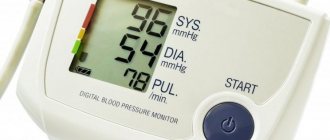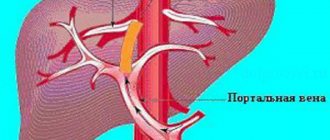Causes of blood pressure surges during SHH
There are many factors that cause changes in blood pressure due to existing osteochondrosis of the cervical spine.
Can it rise?
Can blood pressure increase? Osteochondrosis of the cervical spine is a provoking factor for a rise in blood pressure. This is directly related to the anatomical features of the body: multiple vascular branches depart from the neck area, which provide blood supply to the brain.
In one of the parts of the brain - in the medulla oblongata - there is a vascular center responsible for regulating blood pressure in the human body. With insufficient blood supply, the supply of nutrients and oxygen decreases.
The body regards these manifestations as a result of insufficient blood pressure and stimulates the release of biologically active substances that act on the walls of arterial vessels. The result is vasospasm and an increase in blood pressure.
Factors leading to a rise in blood pressure are:
- insufficiently active lifestyle;
- diseases that provoke circulatory disorders;
- metabolic disorders;
- excess body weight.
Why does low blood pressure occur?
You should know that cervical osteochondrosis does not help lower blood pressure. If the pressure level is low or decreases, you should look for another cause for these conditions.
Consequences
In the absence of therapeutic measures for cervical osteochondrosis and pressure surges, a number of serious complications can arise.
With prolonged osteochondrosis, fever is usually one of the symptoms. But you should not think that the reason for the formation of fever is related to this disease.
Most often, against the background of osteochondrosis, other inflammatory processes worsen. The temperature with osteochondrosis can also increase, this happens against the background of the following conditions:
- spinal canal stenosis;
- spinal disc protrusion;
- myofascial syndrome;
- vertebral artery syndrome.
With this disease, a deterioration in the functioning of the circulatory system as a whole is noted. This leads to the fact that all internal organs begin to suffer (in particular, heart disease develops).
The most terrible complication from osteochondrosis is strokes. When blood flow through the spinal arteries is disrupted, first ischemia and then strokes gain strength.
A person may become disabled because motor function is significantly impaired. In the event of a stroke, it is extremely important to transport the patient to a specialized hospital as quickly as possible, where he will receive qualified care. Otherwise, the risk of irreversible changes is quite high.
Diagnostics
Diagnosis of osteochondrosis of the cervical spine is based primarily on the clinical picture. The results of instrumental research methods are also important. The fundamental points in the diagnosis of this pathology are:
- Collection of anamnestic data. The doctor finds out from the patient the complaints that bother him, how long ago they appeared, and the dynamics of their development. It is also necessary to find out what medications improve the condition and whether there are any hereditary diseases.
- Examination of the patient. It includes examining the skin for the presence of rashes and pathological formations. The range of motion in the cervical spine is determined. By palpation, the presence of any seals is determined.
- X-ray examination of the cervical spine. It is prescribed to assess the condition of the bone structures of this department. Typically, the study is performed in two projections (lateral and direct). Sometimes this diagnostic method is supplemented by the introduction of a contrast agent into a vessel (angiographic study), into the vertebra (discography), or into the spinal canal (myelography).
- Magnetic resonance imaging of the cervical spine (MRI). It is one of the most informative methods of instrumental diagnostics. It does not pose a threat to the patient’s health and allows visualization of structures consisting of soft tissues - nerves, vascular bed, intervertebral discs.
- Computed tomography (CT). The diagnostic method is based on the use of x-rays. It is a more accurate research method than x-ray. It also makes it possible to identify the exact localization of the pathological focus.
- Ultrasound Dopplerography. The study is based on the use of ultrasound radiation. Allows you to evaluate the patency of blood vessels located at the level of the cervical spine and changes in blood flow.
REFERENCE! Increased blood pressure with osteochondrosis of the cervical spine is diagnosed based on the clinical picture and blood pressure measurements.
Diet
Switching to a proper, healthy diet helps to slow down or even stop the development of the pathological process in the cervical vertebrae and joints.
To alleviate the course of the disease, you should include natural foods rich in microelements and vitamins in your diet.
The greatest benefits for osteochondrosis complicated by hypertension can come from::
- dairy products;
- lean meat - beef, rabbit, chicken;
- natural vegetable oils;
- natural honey;
- various berries, vegetables and fruits;
- millet, oatmeal, buckwheat porridge.
It is advisable to avoid certain foods, as they aggravate the course of osteochondrosis. Should be excluded from the menu :
- alcohol;
- strong tea and coffee;
- fat meat;
- rich, concentrated broths;
- buns, candies and sweets;
- salty and smoked food.
How to treat hypertension
Timely identification of the problem and treatment of blood pressure surges is the key to success. Therefore, it is necessary to know how to provide first aid in case of a sharp rise in blood pressure, as well as the necessary medications.
First aid
If blood pressure is high, it is necessary to provide the patient with first aid to avoid adverse consequences.
In case of hypertensive crisis, it is necessary to perform the following algorithm:
- call an ambulance;
- give the patient a semi-lying position; you can place a pillow or blanket under the head and shoulders;
- provide access to fresh air (open the window);
- to warm the patient it is necessary to wrap him up;
- measure pressure;
- give a drug to lower blood pressure, which is taken on an ongoing basis;
- If antihypertensive drugs have not been taken, then you need to take a Captopril tablet under the tongue.
For a stroke, first aid is based on the following actions:
- call an ambulance;
- lay the patient horizontally or on his side with the leg end of the body raised;
- provide a flow of fresh air;
- Monitor the patient's general condition.
Medications
There are several groups of medications that are used to lower blood pressure.
The most commonly used medications to lower blood pressure are Enalapril (Enap), Captopril (Capoten). Captopril is used to urgently and quickly lower blood pressure levels, as it quickly penetrates the systemic circulation.
Also, diuretics are used to normalize blood pressure, for example, Indapamide (Indapafone), Furosemide (Lasix), Hydrochlorothiazide. These drugs help remove fluid from the body, thereby normalizing blood pressure.
By reducing impulse conduction in the heart, normalization of blood pressure is achieved by taking beta-blockers. These include Bisoprolol (Concor), Propranolol (Anaprilin), Metaprolol (Vasocardin).
Blockers of slow calcium channels are also used, which prevent the penetration of calcium ions into the muscle cell, as a result - there is no contraction and vascular spasm. These medications include Nifidipine, Verapamil, Amlodipine.
Medicines of the group of angiotensin receptor inhibitors (angiotensin is a substance that promotes vasospasm) are widely used. When these receptors are blocked, angiotensin does not act on them, resulting in stabilization of pressure. These include the following drugs: Losartan, Valsartan, Telmisartan.
Gymnastics and exercises for hypertension
Physical activity is an important point in the treatment of high blood pressure. Exercises help normalize blood circulation, and as a result, blood pressure:
- Position – lying on your back. You should pull your knees to your chest without using your hands. Breathing is free, the pace of exercise is slow. Repeat 8-10 times.
- The position is arbitrary. It is necessary to slowly clench your fingers into fists. Repeat 8-10 times.
- Position – standing. The arms are bent at the elbows, the palms are placed on the shoulder joints. As you inhale, your elbows spread to the sides, and as you exhale, they move toward your chest. Repeat 4-5 times.
- Position – lying on your back. Arms along the body, palms facing down. As you inhale, turn your palms up, and as you exhale, turn your palms down. Perform 8-10 times.
- Calm breathing for 2 minutes.
- Body position – lying on your back. It is necessary to bend your legs at the knee joints alternately, sliding along the bed. Repeat 6-7 times.
- The body position is similar to the previous one, arms outstretched to the sides. Legs are bent at the knees. It is necessary to lower them alternately in different directions. At the same time, head movements are made in opposite directions. Repeat 5-6 times.
- Position – sitting on a chair. It is necessary to slide your feet along the floor without lifting your feet. Repeat 5-6 times.
- Position – sitting on a chair. As you inhale, spread your arms to the sides, as you exhale, place your palms on your knees, then bend forward. Repeat 5-7 times.
Check out two simple exercises by Dr. Bubnovsky:
Physiotherapy
Physiotherapeutic treatment is widely used to treat hypertension. Methods used for this pathology include:
- Galvanization. The human brain is exposed to low-power electric currents. Electrodes are installed on the occipital or temporal region. The duration of the procedure does not exceed 20 minutes.
- Low frequency magnetic therapy. The basis of the method is the use of a magnetic field, which affects the flow of chemical processes in the body. Special electrodes are installed on the occipital region, which leads to a change in the activity of vascular centers in the brain.
- Ultrahigh frequency therapy. In this case, an alternating electric field is used. Under the influence of this field, metabolism normalizes and the tone of the vascular walls improves.
- Diadenamometry. Treatment is carried out with low-frequency pulsed currents. Electrodes are installed on the back in the projection of the kidneys. Under the influence of these currents, hormonal changes occur in the body, which leads to a decrease in blood pressure.
Traditional methods
In addition to the use of medications, physiotherapy and special exercises, it is possible to normalize blood pressure through traditional medicine methods.
Lemon and garlic
The combination of this citrus fruit with garlic and honey has a fairly effective effect on blood pressure and the condition of blood vessels.
You need to take:
- lemons – 10 pieces;
- garlic – 5 heads;
- honey – 1 kg.
Required:
- prepare food;
- pass the ingredients through a meat grinder;
- combine the resulting mass with honey, transfer to a glass jar;
- Store the container in a refrigerator away from direct sunlight.
The mixture is taken three times a day, 1 teaspoon.
Healing compress
In order to reduce pressure, it is possible to perform special therapeutic compresses.
For apple cider vinegar compresses you will need:
- apple cider vinegar – 100 ml;
- water – 200 ml;
- gauze napkins.
Apple cider vinegar is diluted with water in a ratio of 1:2. Napkins are moistened in the resulting solution and placed on the feet. The duration of the compress is 15 minutes.
To prepare compresses with table vinegar you need to take:
- table vinegar – 100 ml;
- water – 200 ml;
- gauze napkins.
The application of compresses is similar to those using apple cider vinegar. You can also wipe the temporal and occipital areas with the resulting solution.
Tea
It is known that strong black tea contains a sufficient amount of caffeine, which helps to increase blood pressure. But weakly brewed tea, to which a spoonful of honey and a few drops of lemon juice are added, has the opposite effect - it quickly and gently reduces high blood pressure.
IMPORTANT! It is worth remembering that teas based on honeysuckle, lingonberry, and cranberry will be no less effective in this case.
Dairy products
With a slight increase in pressure level, its reduction is possible with the help of any fermented milk products. For example, fermented baked milk, kefir, drinking yogurt, yogurt.
It is possible to combine them with products such as spinach, almonds, dill. Such mixtures can be an ideal breakfast for those who suffer from hypertension.
Normalization of low pressure
If a drop in blood pressure occurs due to stress, overload of the body, as well as under the influence of other factors, then emergency assistance is needed, which can be provided at home.
An increase in blood pressure can be achieved:
- drinking black strong sweet tea;
- ventilation of the room in which the person is located;
- raising the leg end of the body;
- deep and measured breathing;
- freeing the chest from constricting clothing;
- taking a contrast shower;
- eating sweets;
- using tincture of ginseng or lemongrass.
Medicines that can be used:
- drugs whose active substance is caffeine (for example, sodium caffeine benzoate);
- psychostimulant medications;
- herbal medicines (for example, Eleutherococcus extract);
- vitamin and mineral complexes.
Spinal support and discomfort relief
Back problems can be divided into problems of osteoarticular origin, which are most often associated with degenerative conditions, muscle pain and compression of nerve structures. Unfortunately, in many cases, correction is difficult and sometimes even impossible, so the most common therapy for patients reporting such problems is symptomatic treatment. For minor to moderate symptoms, the use of paracetamol alone is sufficient, but in case of inflammatory pain, a medicine with an anti-inflammatory component should be taken.
It is important to always follow the pain management guidelines prepared by WHO for accurate drug selection:
- minor pain - non-opioid analgesics (paracetamol, NSAIDs),
- when pain persists or increases - weak opioid analgesics (Tramadol, Codeine),
- when pain persists or increases and is significant: strong opioids (Morphine, Fentanyl, Methadone).
Risk of NSAID use when coexisting with hypertension
Despite WHO recommendations for the use of drugs in accordance with proper pain management, when determining analgesic pharmacotherapy, it is always necessary to conduct a conversation with the patient and determine whether there are contraindications to the use of specific groups of drugs. As mentioned at the beginning, in a certain group of patients, spinal disorders can coexist with hypertension. In such individuals, chronic therapy with non-steroidal anti-inflammatory drugs should not be used, since they increase blood pressure and adversely affect the effectiveness of therapy.
The negative effect of NSAIDs on the cardiovascular system is associated, in particular, with disturbances in the synthesis of proinflammatory mediators: thromboxane, prostacyclins, prostaglandins. In the body, there is a disturbance in the level of thromboxane and prostacyclin in the vascular endothelium, which leads to vasospasm. These drugs affect the disruption of lipid oxidation, and this may further influence the risk of thromboembolic complications, hypertension and atherosclerosis. Even selective drugs reduce sodium excretion by the kidneys, which can lead to increased blood pressure. In addition, studies have shown that NSAIDs may reduce the effects of diuretics (mainly thiazides), ACE inhibitors and beta blockers, and prazosin, with perhaps the least significant effect observed with calcium antagonists. For cardiovascular diseases, including hypertension,
Another problem is the numerous drug interactions of NSAIDs. Therefore, their use in pharmacotherapy is often associated with the risk of side effects. The additional risk associated with this group of drugs is due to their belonging to the OTC category and, therefore, the possibility of self-medication. The main reason for this is the belief that if a drug is available without a prescription, it means it is safe. The majority of people (49%) share this opinion when it comes to pain relievers, of which about 19% reduce bone and joint pain. Unfortunately, some of them do not consult a doctor or pharmacist at all.
Prevention
Preventive measures include:
- normalization of the daily routine;
- avoiding excessive stress;
- maintaining physical activity;
- frequent exposure to fresh air;
- reduction of excess body weight.
Osteochondrosis of the cervical spine and hypertension are two pathologies that often occur together. Preventive measures should be taken to avoid these conditions, and if they occur, early diagnosis and appropriate treatment are necessary.
First aid
If your health suddenly deteriorates due to low or high blood pressure, you must call an ambulance. Then you need to remove constrictive clothing or unfasten buttons, take a reclining position, and cover your legs with a warm blanket. As a rule, in such a state a person becomes restless, anxiety, fear appear, and panic attacks are possible. You should take 10-15 drops of motherwort or valerian tincture. Nifedipine, Captopril or Moxonidine can be used to lower blood pressure. Strong, sweet tea, tinctures of Eleutherococcus, and ginseng will help increase blood pressure.
Possible complications
In the absence of treatment for osteochondrosis, which is accompanied by high blood pressure, the condition of the blood vessels quickly deteriorates. As a result, hypertrophied heart syndrome, retinal angiopathy, and transient cerebrovascular accident occur. Constantly reduced blood pressure causes the development of thrombophlebitis, varicose veins, pulmonary embolism, and ischemic stroke.











